
- Afhalen na 1 uur in een winkel met voorraad
- Gratis thuislevering in België vanaf € 30
- Ruim aanbod met 7 miljoen producten
- Afhalen na 1 uur in een winkel met voorraad
- Gratis thuislevering in België vanaf € 30
- Ruim aanbod met 7 miljoen producten
Zoeken
€ 58,45
+ 116 punten
Omschrijving
Over the last decade the regulatory evaluation of environmental and public health risks has been one of the most legally controversial areas of contemporary government activity. Much of that debate has been understood as a conflict between those promoting 'scientific' approaches to risk evaluation and those promoting 'democratic' approaches. This characterization of disputes has ignored the central roles of public administration and law in technological risk evaluation. This is problematic because, as shown in this book, legal disputes over risk evaluation are disputes over administrative constitutionalism in that they are disputes over what role law should play in constituting and limiting the power of administrative risk regulators. This is shown by five case studies taken from five different legal cultures: an analysis of the bifurcated role of the Southwood Working Party in the UK BSE crisis; the development of doctrines in relation to judicial review of risk evaluation in the US in the 1970s; the interpretation of the precautionary principle by environmental courts and generalist tribunals carrying out merits review in Australia; the interpretation of the WTO Sanitary and Phytosanitary Agreement as part of the WTO dispute settlement process; and the interpretation of the precautionary principle in the EU context. A strong argument is thus made for re-orienting the focus of scholarship in this area.
Specificaties
Betrokkenen
- Auteur(s):
- Uitgeverij:
Inhoud
- Aantal bladzijden:
- 256
- Taal:
- Engels
Eigenschappen
- Productcode (EAN):
- 9781849460880
- Verschijningsdatum:
- 1/07/2010
- Uitvoering:
- Paperback
- Formaat:
- Trade paperback (VS)
- Afmetingen:
- 156 mm x 234 mm
- Gewicht:
- 453 g

Alleen bij Standaard Boekhandel
+ 116 punten op je klantenkaart van Standaard Boekhandel
Beoordelingen
We publiceren alleen reviews die voldoen aan de voorwaarden voor reviews. Bekijk onze voorwaarden voor reviews.








